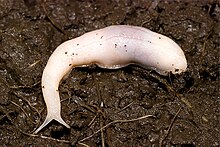Trigonochlamydidae
| Trigonochlamydidae Temporal range:
| |
|---|---|

| |
| Ghost slug, Selenochlamys ysbryda | |
| Scientific classification | |
| Domain: | Eukaryota |
| Kingdom: | Animalia |
| Phylum: | Mollusca |
| Class: | Gastropoda |
| Order: | Stylommatophora |
| Infraorder: | Limacoidei |
| Family: | Trigonochlamydidae Hesse, 1882 |
| Subfamilies and genera[2] | |
| |
| Diversity | |
| 9 genera, 11 species | |
Trigonochlamydidae is a family of air-breathing land slugs, terrestrial gastropod molluscs in the clade Eupulmonata (according to the taxonomy of the Gastropoda by Bouchet & Rocroi, 2005).
Distribution
[edit]The native distribution of Trigonochlamydidae includes Caucasus,[1] Iran and Turkey.[3]
Taxonomy
[edit]Previously, Trigonochlamydidae was placed in the superfamily Trigonochlamydoidea Hesse, 1882, in the subinfraorder Sigmurethra. This was the only family within that superfamily.[4]
The family Trigonochlamydidae is now classified within the limacoid clade, which itself belongs to the clade Stylommatophora, within the clade Eupulmonata (according to the taxonomy of the Gastropoda by Bouchet & Rocroi, 2005).
The following two subfamilies have been recognized in the taxonomy of Bouchet & Rocroi (2005):
- subfamily Trigonochlamydinae Hesse, 1882 – synonyms: Selenochlamydinae I. M. Likharev & Wiktor, 1980
- subfamily Parmacellillinae Hesse, 1926[5]
Genera
[edit]There are nine[3] genera in the family Trigonochlamydidae with a total of 11 species:
Subfamily Trigonochlamydinae
- Boreolestes Schileyko & Kijashko, 1999
- Boreolestes likharevi Schileyko & Kijashko, 1999 – type species[6]
- Boreolestes sylvestris Kijashko in Schileyko & Kijashko, 1999[6]
- Drilolestes Lindholm, 1925 – with only one species Drilolestes retowskii (O. Boettger, 1884)[6]
- Hyrcanolestes Simroth, 1901 – with only one species Hyrcanolestes velitaris (Martens, 1880)[6]
- Khostalestes Suvorov, 2003[3] – with only one species Khostalestes kochetkovi Suvorov, 2003[3][6]
- Lesticulus Schileyko, 1988 – with only one species Lesticulus nocturnus Schileyko, 1988[6]
- Trigonochlamys O. Boettger, 1881 – type genus of the family Trigonochlamydidae, with only one species Trigonochlamys imitatrix O. Boettger, 1881[6]
- Troglolestes Ljovushkin & Matiokin, 1965 – with only one species Troglolestes sokolovi Liovushkin & Matiokin, 1965[6]
Subfamily Parmacellillinae
- Parmacellilla Simroth, 1910 – type genus of the subfamily Parmacellillinae, with only one species Parmacellilla filipowitschi Simroth, 1910[7]
Synonym:
- Pseudomilax O. Boettger, 1881 is a synonym for various genera in Trigonochlamydidae.
Selenochlamys O. Boettger, 1883 has been removed from the Trigonochlamydidae to the Oxychilidae based on DNA evidence.[8]
Cladogram
[edit]The following cladogram shows the phylogenic relationships of this family with the other families in the limacoid clade:[9]
References
[edit]- ^ a b "Family summary for Trigonochlamydidae". AnimalBase, last modified 26 August 2005, accessed 1 September 2010.
- ^ MolluscaBase eds. (2024). MolluscaBase. Trigonochlamydidae Hesse, 1882. Accessed through: World Register of Marine Species at: https://www.marinespecies.org/aphia.php?p=taxdetails&id=867826 on 21 August 2024
- ^ a b c d Suvorov A. N. (2003). "A new species and genus of carnivorous slugs (Pulmonata Trigonochlamydidae) from West Transcaucasia". Ruthenica 13: 149–152. abstract.
- ^ Sistemica (Spanish list of genera), cited 7 October 2008.
- ^ Hesse P. (1926). "Die Nacktschnecken der palearktischen Region". Abhandlungen des Archiv für Molluskenkunde 2(1): 1–152. page 47 and page 54. plates 1–2.
- ^ a b c d e f g h Kantor Yu I., Vinarski M. V., Schileyko A. A. & Sysoev A. V.(published online on 22 December 2009). "Catalogue of the continental mollusks of Russia and adjacent territories". Version 2.3.
- ^ Schileyko A. A. (2003). "Treatise on Recent Terrestrial Pulmonate Molluscs. Part 11. Trigonochlamydidae, Papillodermidae, Vitrinidae, Limacidae, Bielziidae, Agriolimacidae, Boettgerillidae, Camaenidae." Ruthenica, Supplement 2(11): 1467–1626, Moscow. page 1467.
- ^ Neiber, Marco T.; Walther, Frank; Hausdorf, Bernhard (October 2020). "Phylogenetic relationships of ghost slugs (Selenochlamys) and overlooked instances of limacization in Western Palaearctic Limacoidei (Gastropoda: Stylommatophora)". Molecular Phylogenetics and Evolution. 151: 106897. Bibcode:2020MolPE.15106897N. doi:10.1016/j.ympev.2020.106897. PMID 32585288.
- ^ Hausdorf B. (March 2000). "Biogeography of the Limacoidea sensu lato (Gastropoda: Stylommatophora): Vicariance Events and Long-Distance Dispersal". Journal of Biogeography 27(2): 379–390. doi:10.1046/j.1365-2699.2000.00403.x, JSTOR.
